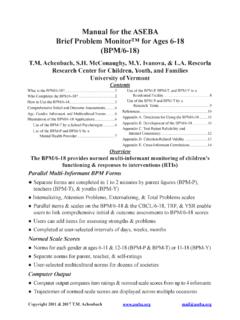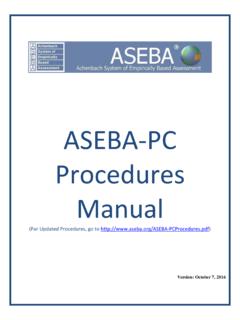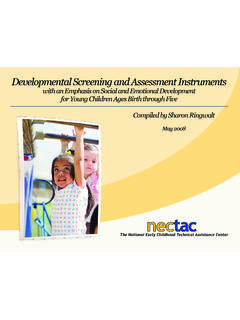Transcription of Executive Skills in Children and Adolescents with ADHD
1 Smart but Scattered: Helping Children and Adolescents with Executive Dysfunction at Home and at School Peg Dawson, Center for Learning and Attention Disorders Portsmouth, New Hampshire The Cookie Problem Problem to be solved: Who wore which color? Rachel, Linda and Eve were friends sitting in a circle on the grass. Rachel passed 3 chocolate chip cookies to the person in blue. Who wore which color? Eve passed 3 macaroons to the person who passed her cookies to the person wearing green. Each person passed 3 cookies to the friend on her left. Rachel, Linda, and Eve were dressed in red, blue, and green, but not necessarily in that order.
2 The person who wore green did not get a macaroon. The person wearing red passed along 3 oatmeal cookies. Who wore which color? Rachel Green Eve Blue Linda Red Chocolate chip Macaroons Oatmeal The Cookie Problem What do I need to know? (Which person wore which color?) What do I know now? (All the individual clues) How can I organize this information to make sense of it? ( , draw a diagram or create a chart) What is my plan? ( , Fill in the diagram bit by bit; start with an anchor clue; go on to each clue until the diagram is filled; check all the clues to make sure everything fits) Executive Skills : Definitions Response Inhibition: The capacity to think before you act this ability to resist the urge to say or do something allows us the time to evaluate a situation and how our behavior might impact it.
3 Working Memory: The ability to hold information in memory while performing complex tasks. It incorporates the ability to draw on past learning or experience to apply to the situation at hand or to project into the future. What working memory looks like in a 15-year old What working memory looks like in a 15-year old-- and what impact does it have on parents? Executive Skills : Definitions Response Inhibition: The capacity to think before you act this ability to resist the urge to say or do something allows us the time to evaluate a situation and how our behavior might impact it. Working Memory: The ability to hold information in memory while performing complex tasks.
4 It incorporates the ability to draw on past learning or experience to apply to the situation at hand or to project into the future. Emotional Control: The ability to manage emotions in order to achieve goals, complete tasks, or control and direct behavior. Executive Skills : Definitions Flexibility: The ability to revise plans in the face of obstacles, setbacks, new information or mistakes. It relates to an adaptability to changing conditions. Sustained Attention: The capacity to maintain attention to a situation or task in spite of distractibility, fatigue, or boredom. Executive Skills : Definitions Flexibility: The ability to revise plans in the face of obstacles, setbacks, new information or mistakes.
5 It relates to an adaptability to changing conditions. Sustained Attention: The capacity to maintain attention to a situation or task in spite of distractibility, fatigue, or boredom. Task Initiation: The ability to begin projects without undue procrastination, in an efficient or timely fashion. What task initiation looks like in a 15-year old What task initiation looks like in a 15-year old-- and what impact does it have on parents? Executive Skills : Definitions Flexibility: The ability to revise plans in the face of obstacles, setbacks, new information or mistakes. It relates to an adaptability to changing conditions.
6 Sustained Attention: The capacity to maintain attention to a situation or task in spite of distractibility, fatigue, or boredom. Task Initiation: The ability to begin projects without undue procrastination, in an efficient or timely fashion. Planning/Prioritization: The ability to create a roadmap to reach a goal or to complete a task. It also involves being able to make decisions about what s important to focus on and what s not important. Executive Skills : Definitions Organization: The ability to create and maintain systems to keep track of information or materials. Time Management: The capacity to estimate how much time one has, how to allocate it, and how to stay within time limits and deadlines.
7 It also involves a sense that time is important. Goal-directed persistence: The capacity to have a goal, follow through to the completion of the goal and not be put off or distracted by competing interests. Metacognition: The ability to stand back and take a birds-eye view of oneself in a situation. It is an ability to observe how you problem solve. It also includes self-monitoring and self-evaluative Skills ( , asking yourself, How am I doing? or How did I do? ). Why is it important to help kids develop Executive Skills ? Where in the brain are Executive Skills located? In the frontal lobes (just behind the forehead) DEFINITIONS/ CONCEPTUALIZATIONS Frontal lobes decide what is worth attending to and what is worth doing.
8 Impairments manifest as distractibility, poor sustained attention and effort, perseveration, and confusion. Frontal lobes provide continuity and coherence to behavior across time. Impairments are manifested in the inability to plan and execute a sequence of behaviors needed to meet a goal. Frontal lobes modulate affective and interpersonal behavior so that drives are satisfied within the constraints of the internal and external environments. Impairments are manifested as emotional lability, flatness and indifference, irritability and belligerence, and childishness. The frontal lobes monitor, evaluate, and adjust. Impairments are manifested as rigidity, lack of insight, and an inability to profit from experience.
9 BARKLEY S THEORY OF ADHD CONTINGENCY-SHAPED/CONTEXT DEPENDENT SUSTAINED ATTENTION VERSUS GOAL-DIRECTED PERSISTENCE CONTENGENCY-SHAPED/CONTEXT-DEPENDENT SUSTAINED ATTENTION A person s sustained response depends on: Novelty Intrinsic Reinforcement (Interest) Value Extrinsically Provided Consequences Therefore, if the task is: Fun Interesting Immediately Rewarding on-task behavior can be sustained ( , TV, video games, hands-on activities). Goal Directed Persistence Requires the individual to Generate and hold a mental representation of the goal in mind (working memory). Formulate a plan and set of rules to follow (self-directed speech).
10 Inhibit and regulate negative affect ( , disappointment and frustration) associated with self-deprivation. Kindle self-motivated or positive drive states in support of the plan (self-regulation of affect). Experiment with multiple novel approaches toward goal achievement before selecting one to perform (reconstitution). THE INDIVIDUAL with ADHD HAS DIMINISHED SELF-REGULATION ..therefore sustained attention is highly context and contingency dependent. Without rewards or interest in the immediate context, work is cut short. THE INDIVIDUAL WITHOUT ADHD HAS ADEQUATE SELF-REGULATION therefore s/he requires no source of reward or motivation in the immediate context for performance.




